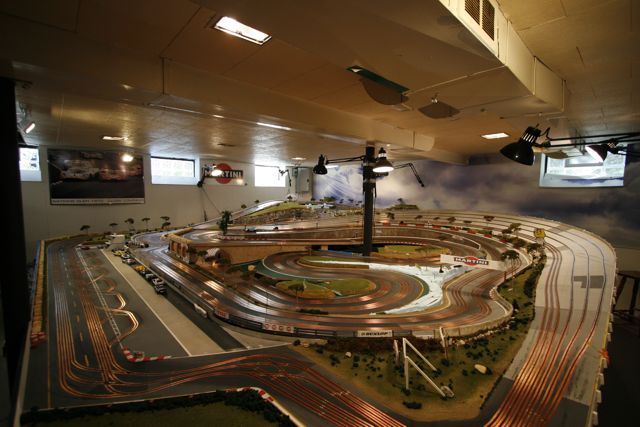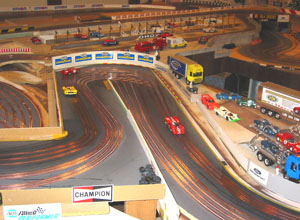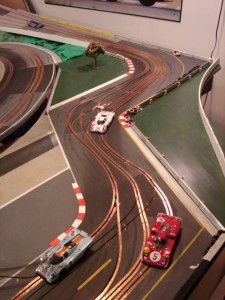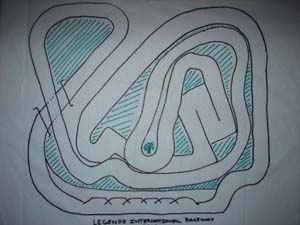Finally got around to making a new site format. Make sure you check out the updated gallery section. This page will contain the latest news and questions answered by Bryan, Dave and Jimmy. Look for more content on scenery, lap timing and layout coming soon. Jimmy will also add frequently asked questions here.
You can leave comments on this page by becoming a registered user. Register

For your lane changer, we know that you use a 12 volt solenoid and return spring connected to a bent 1/8 steel rod to guide the shoe from one lane to the other. But when you run two cars (“A” and “B”) in a lane, both run very fast and near one another. Say car “A” is first, and “B” goes through second. But, both cars run nose to tail. How do the drivers of car A or B put on the switch and not disturb the other car? How the does the switch “know” who wants to change the lane and who does not want to do it? Can the A driver send a different signal to the switch than the B driver?
First see our Lane Changing Page.
The problem of a driver holding his lane change button down too long sounds worse than it is. Yes, both A and B driver’s buttons are wired in parallel to the same switch. No fancy electronics are really needed. The decisions are totally up to the driver. If driver A wants to be kicked off my track, he can just keep holding the button down as driver B  goes through the hairpin turn where the lane change switches are. There must be discipline in any form of racing. The decisions are totally up to the drivers. If they just change lanes blindly, they are going to ruin the race. Anyone model racing with two or more cars per lane must adhere to the same common sense rules that apply to all forms of racing, or be black flagged. We are not just watching toy cars zip around here! We are miniature racing. We are replicating an actual car race of a period with the finest scale models that we can build or buy. On digital race tracks the cars seem to be flying around like magnetized bumble bees stuck to the track. The track’s electronics on these sets, does the thinking for the drivers. The only time the cars look like real race cars is when they get picked up off the floor after they bash together at the switches! The secret to a good AC2Car routed track, which allows two cars to run in the same slot, is that the track needs to have it’s lane changing area designed just past a chicane, or hairpin. Just before the switches, the track necks down to force the field of cars to go through a tight roadway more slowly, and in single file. This not only minimizes shunts that occur as cars cross other lanes, but it allows the time to make a decision as to whether to stay in the regular lane or cross to the passing lane. Something that digital cannot provide. Again, holding the lane change button down as the other car goes over the lane change switch does accidentally happen, but it’s rare. The way we race, if a slower car is blocking, 1) The slow driver will let the faster car pass. No different than what is expected in real racing! 2) The faster car that needs to get by will drop back as he comes to the switch, because he not only has to negotiate the hairpin turn, or chicane slowly in single file, but he needs
goes through the hairpin turn where the lane change switches are. There must be discipline in any form of racing. The decisions are totally up to the drivers. If they just change lanes blindly, they are going to ruin the race. Anyone model racing with two or more cars per lane must adhere to the same common sense rules that apply to all forms of racing, or be black flagged. We are not just watching toy cars zip around here! We are miniature racing. We are replicating an actual car race of a period with the finest scale models that we can build or buy. On digital race tracks the cars seem to be flying around like magnetized bumble bees stuck to the track. The track’s electronics on these sets, does the thinking for the drivers. The only time the cars look like real race cars is when they get picked up off the floor after they bash together at the switches! The secret to a good AC2Car routed track, which allows two cars to run in the same slot, is that the track needs to have it’s lane changing area designed just past a chicane, or hairpin. Just before the switches, the track necks down to force the field of cars to go through a tight roadway more slowly, and in single file. This not only minimizes shunts that occur as cars cross other lanes, but it allows the time to make a decision as to whether to stay in the regular lane or cross to the passing lane. Something that digital cannot provide. Again, holding the lane change button down as the other car goes over the lane change switch does accidentally happen, but it’s rare. The way we race, if a slower car is blocking, 1) The slow driver will let the faster car pass. No different than what is expected in real racing! 2) The faster car that needs to get by will drop back as he comes to the switch, because he not only has to negotiate the hairpin turn, or chicane slowly in single file, but he needs  to see which side of the track the car in front decides to choose to race on. No one can pass you because the whole field of cars behind your car are forced into single file as they go through the tight hairpin or chicane. Just like real racing, a driver sees which side of the roadway the slower car chooses as it exits the turn and he takes the opposite side. This careful planning allows him the whole next lap, to beat the other car back to the lane switching area. Each time the cars slow and regroup at the hairpin, or a chicane, that decision is made again. No different than what Mario Andretti needed to do at narrow chicanes and hairpin turns on every lap, of every race, he ever ran in. If a driver on a track with two cars in one lane, does not race as the real cars do, than he deserves not to race on tracks such as these. He should go and spend triple digits on a digital set that does the thinking for him. That way he can watch cars fly around mindlessly, at least until one or two of them end up side swiped off the track.
to see which side of the track the car in front decides to choose to race on. No one can pass you because the whole field of cars behind your car are forced into single file as they go through the tight hairpin or chicane. Just like real racing, a driver sees which side of the roadway the slower car chooses as it exits the turn and he takes the opposite side. This careful planning allows him the whole next lap, to beat the other car back to the lane switching area. Each time the cars slow and regroup at the hairpin, or a chicane, that decision is made again. No different than what Mario Andretti needed to do at narrow chicanes and hairpin turns on every lap, of every race, he ever ran in. If a driver on a track with two cars in one lane, does not race as the real cars do, than he deserves not to race on tracks such as these. He should go and spend triple digits on a digital set that does the thinking for him. That way he can watch cars fly around mindlessly, at least until one or two of them end up side swiped off the track.
No need to specifically use a train transformer, but we just thought it would be easiest to point guys to those. They have good adjustable voltage range and are easy to wire up and available on eBay.com for not too much money.

How do the marshals get inside the track to put the cars back on the Legends Track?
Unlike my Northline Raceway, right from the start we designed Dave’s Legends track to be set up to use 2 foot gripper tools. I began using them for the kids to use when marshaling at my track. Grippers are 24 inch long wands with hand controlled clamping abilities used to reach high shelves or install light bulbs in high places. They are sold under different names at hardware stores. They have rubber claws that hold a race car firmly, yet gently. We did design in an access point in the middle of Dave’s track, but it will only be used for construction purposes and may be covered with a lift off removable scenery panel. There were about 5 places on Legends that I thought would only be accessible using a Gripper, but as it turns out three of those marshaling points can be reached by most adults. By extending a marshal’s reach another 2 feet, we were able to design in far more track to race on. If had to design my track over again, I’d worry less about accessibility and add more linear feet of track into the space. The AC2Car form of racing is more disciplined than magnetic “rhythm” racing. Cars on AC2Car tracks do need marshaling, but the models are not flashing around in a blur, flying off all the time. However I have to admit, that when the kids race here we have more than out share of fetching downed cars. But, the Gripper type tools work well.



